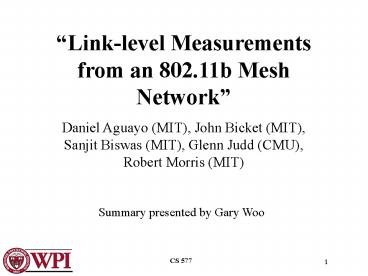- PowerPoint PPT Presentation
Title:
Description:
Run early Sunday morning June 6th, 2004. 1500 byte 802.11 broadcast for 90 seconds ... High signal and low noise should result in delivery. Roofnet doesn't show ... – PowerPoint PPT presentation
Number of Views:100
Avg rating:3.0/5.0
Title:
1
Link-level Measurements from an 802.11b Mesh
Network
- Daniel Aguayo (MIT), John Bicket (MIT), Sanjit
Biswas (MIT), Glenn Judd (CMU), Robert Morris
(MIT)
Summary presented by Gary Woo
2
Outline
- Assumptions in neighbor abstraction
- What is Roofnet?
- Experiment/Results
- Hypotheses
- Cause
- Conclusion
- Additional experiments
3
Neighbor abstraction
- Nodes are divided into pairs that can communicate
and pairs that can not - Examples of usage
- Wired networks
- Obvious physical connection
- MAC protocol in 802.11
- Supported based on S/N and BER relationship
4
Roofnet
- Located in Cambridge, MA next to MIT
- 38 nodes with roof top antennas
5
Experiment setup
- Use 802.11b cards with Prism 2.5 chip set
- Set to channel 3 (2.422Ghz)
- Pseudo-IBSS (ad hoc) mode
- Run early Sunday morning June 6th, 2004
- 1500 byte 802.11 broadcast for 90 seconds
- Sequence Number, Arrival Time, Receive Signal
Strength Indication (RSSI), Silence values are
saved
6
Results
Red expected
- Results show that nodes dont adhere to
neighbor abstraction
7
Delivery probability burstyness
- Average loss rate are all about 50
8
Loss due to long interference?
- Allan Deviation of loss rate measures
fluctuations (high means very bursty, low means
more smooth)
Yellow box shows that around 80 of all pairs
have low Allan Deviation of loss rate (around
0.06)
9
Loss due to distance?
- Yellow circles are the same size (approximately
centered around Sender) - There is relation of distance/receiving signal,
however not consistent
10
Loss due to noise?
- High signal and low noise should result in
delivery - Roofnet doesnt show strong correlation
Result for1 Mbit/s High signal packets still
lost
11
Loss due to 802.11 interference?
Few interference packets before experiment
- If cause is this interference, then the more
interference packets the more packets would be
drop
12
So what is the cause?
- when you have eliminated the impossible,
whatever remains, however improbable, must be the
truth Sherlock Holmes in The Adventure of the
Beryl Coronet (1892)
13
Reflected signals
- Buildings and other physical objects reflects
signals - Weaker duplicated signal are received by nodes
after a delay - RAKE receiver can suppress reflected copies with
delays up to 250 nanoseconds
14
Experiment for reflected signals
- Signal sent to the receiver, and combined with a
duplicated version of the original signal (with
added delay, and reduce strength)
15
Results for reflected signals experiment
- Yellow shows RAKE working
- Green shows loss if reflected signal is almost as
powerful as original the receiver is confused - Blue shows intersection with the modulations
symbol boundaries
16
Results for reflected signals experiment
(continued)
17
Distance between links
- Most links have greater than 500 nanosecond
delays, RAKE cant handle
18
Conclusion
- No clear distinction of links that drop a lot of
packets verses ones that receive most - Link distance and Signal to Noise ratio has
relation but not strong - Most likely cause is multi-path fading (reflected
signals)
19
Varying signal strength
1 Mbit/s
- The stronger the signal, the higher the
probability of being delivered
20
Throughput compared based on bit rate
Shaded portion shows that X Mbit/s can
successfully send more packets than other rates
- Algorithm should wait until delivering half the
packets before reducing bit rate
21
References and Acknowledgements
- Author's slides for SIGCOMM 2004 (figures in
color were taken from these slides) - http//www.pdos.lcs.mit.edu/roofnet/sigcomm-talk.p
pt - Authors electronic version of paper (other
figures and tables were taken from this
document) - http//www.pdos.lcs.mit.edu/rtm/papers/p442-aguay
o.pdf - Roofnets group website
- http//www.pdos.lcs.mit.edu/roofnet/index.php































